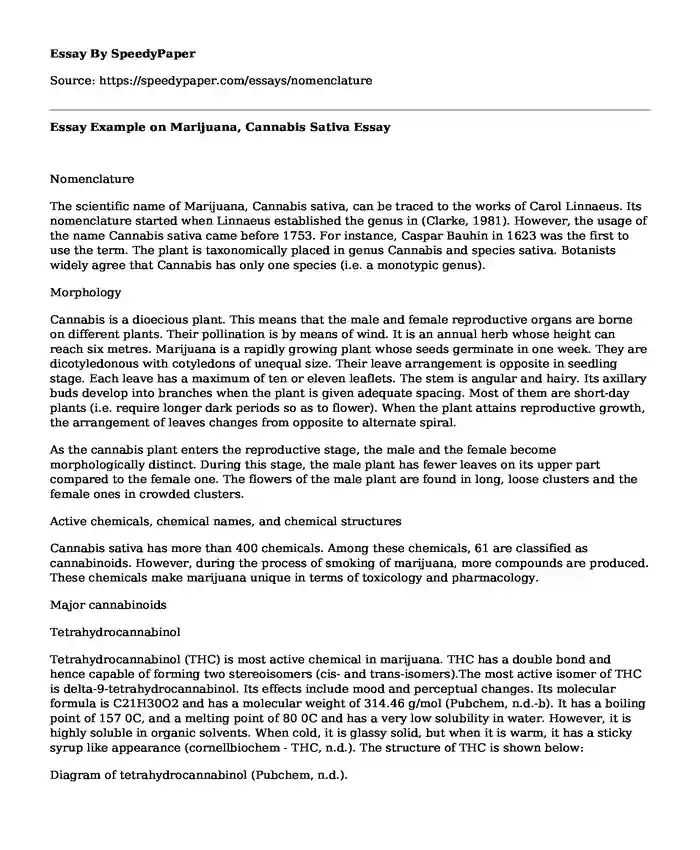
| Type of paper: | Essay |
| Categories: | Biology Medicine Chemistry Marijuana legalization |
| Pages: | 4 |
| Wordcount: | 900 words |
Nomenclature
The scientific name of Marijuana, Cannabis sativa, can be traced to the works of Carol Linnaeus. Its nomenclature started when Linnaeus established the genus in (Clarke, 1981). However, the usage of the name Cannabis sativa came before 1753. For instance, Caspar Bauhin in 1623 was the first to use the term. The plant is taxonomically placed in genus Cannabis and species sativa. Botanists widely agree that Cannabis has only one species (i.e. a monotypic genus).
Morphology
Cannabis is a dioecious plant. This means that the male and female reproductive organs are borne on different plants. Their pollination is by means of wind. It is an annual herb whose height can reach six metres. Marijuana is a rapidly growing plant whose seeds germinate in one week. They are dicotyledonous with cotyledons of unequal size. Their leave arrangement is opposite in seedling stage. Each leave has a maximum of ten or eleven leaflets. The stem is angular and hairy. Its axillary buds develop into branches when the plant is given adequate spacing. Most of them are short-day plants (i.e. require longer dark periods so as to flower). When the plant attains reproductive growth, the arrangement of leaves changes from opposite to alternate spiral.
As the cannabis plant enters the reproductive stage, the male and the female become morphologically distinct. During this stage, the male plant has fewer leaves on its upper part compared to the female one. The flowers of the male plant are found in long, loose clusters and the female ones in crowded clusters.
Active chemicals, chemical names, and chemical structures
Cannabis sativa has more than 400 chemicals. Among these chemicals, 61 are classified as cannabinoids. However, during the process of smoking of marijuana, more compounds are produced. These chemicals make marijuana unique in terms of toxicology and pharmacology.
Major cannabinoids
Tetrahydrocannabinol
Tetrahydrocannabinol (THC) is most active chemical in marijuana. THC has a double bond and hence capable of forming two stereoisomers (cis- and trans-isomers).The most active isomer of THC is delta-9-tetrahydrocannabinol. Its effects include mood and perceptual changes. Its molecular formula is C21H30O2 and has a molecular weight of 314.46 g/mol (Pubchem, n.d.-b). It has a boiling point of 157 0C, and a melting point of 80 0C and has a very low solubility in water. However, it is highly soluble in organic solvents. When cold, it is glassy solid, but when it is warm, it has a sticky syrup like appearance (cornellbiochem - THC, n.d.). The structure of THC is shown below:
Diagram of tetrahydrocannabinol (Pubchem, n.d.).
CannabinolIts IUPAC name is 6,6,9-trimethyl-3-pentylbenzo[c]chromen-1-ol. It has a molecular formula of C21H26O2 and a molecular weight of 310.43 g/mol (Pubchem, n.d.-a). It has a melting point of approximately 77 0C and a boiling point of 185 0C. This chemical appears as thin leaflets. The structure of cannabinol is shown below:
Diagram of tetrahydrocannabinol (Pubchem, n.d.).
ArachidonylethanolamideIts IUPAC name is (5Z,8Z,11Z,14Z)-N-(2-hydroxyethyl)icosa-5,8,11,14-tetraenamide. It has a molecular formula of C22H37NO2 and a molecular weight of 347.53g/mol. Its density is 0.94 g/cm3. It has a boiling point of approximately 522.3 0C at 760 mmHg. It is soluble in organic solvents e.g. ethanol but has very low solubility in water. The structure arachidonylethanolamide is shown below:
Diagram of tetrahydrocannabinol (Pubchem, n.d.).
CannabidiolIts IUPAC name is 2-[(1R,6R)-3-methyl-6-prop-1-en-2-ylcyclohex-2-en-1-yl]-5-pentylbenzene-1,3-diol. It has a molecular formula of C21H30O2 and a molecular weight of 314.46 g/mol. Its density is 1.025 g/cm3. Cannabidiol has a boiling point of approximately 463.9 0C and a flash point of 206.3 0C. This chemical appears as white crystalline powder. The structure of cannabidiol is shown below:
Diagram of tetrahydrocannabinol (Pubchem, n.d.).
CannabichromeneIts IUPAC name is 2-methyl-2-(4-methylpent-3-enyl)-7-pentylchromen-5-ol. It has a molecular formula of C21H30O2 and a molecular weight of 314.46 g/mol. It has a boiling point of approximately 428 0C at 760 mmHg and a flash point of 174.20 0C. It is soluble in organic solvents e.g. ethanol but has very low solubility in water. The structure of cannabichromene is shown below:
Diagram of tetrahydrocannabinol (Pubchem, n.d.).
Medical uses of marijuana
Introduction
Even though Marijuana has been found to have negative health effects such as depression, anxiety, and rapid heartbeats, recent research studies have shown medical benefits of this plant. Some of the medical uses include stimulation of appetite and treatment of nausea, glaucoma, movement disorders, analgesia, schizophrenia, and neuropsychiatric disorders.
Stimulation of appetite and alleviation of cachexia
The biggest problem facing patients suffering from HIV and cancer are a loss of weight and reduced caloric intake. In healthy people, inhaled marijuana has been found to increase appetite as well as food intake. Similarly, studies have found that dronabinol (or THC) leads to increase in appetite and a subsequent increase in weight in patients with HIV and Aids. Therefore, marijuana can be the least expensive treatment for these medical conditions in AIDS and cancer.
Nausea and vomiting treatment
Nausea and vomiting occur when sensory centres found in the brain and the digestive tract undergo stimulation. Emesis (or vomiting) is a complex process involving the coordination of various body systems such as digestive, respiratory, and posture. On the other hand, the mechanisms behind nausea are not well known. However, it is believed to arise from brain activity
Cite this page
Essay Example on Marijuana, Cannabis Sativa. (2019, Sep 03). Retrieved from https://speedypaper.com/essays/nomenclature
Request Removal
If you are the original author of this essay and no longer wish to have it published on the SpeedyPaper website, please click below to request its removal:
- Essay Example on the Internet Security Issue
- Research Assessment Statement on Food Safety Regulation, Essay Example
- Free Essay on the HR Department
- Free Essay on Elements of Success According to Malcolm Gladwell: Timing vs. Time
- XM and Sirius Radio, Business Essay Example
- Free Essay on Evidence-Based Nursing Practice: Main Issues for Organizations
- Free Essay: Sears Hometown Goods Training
Popular categories




